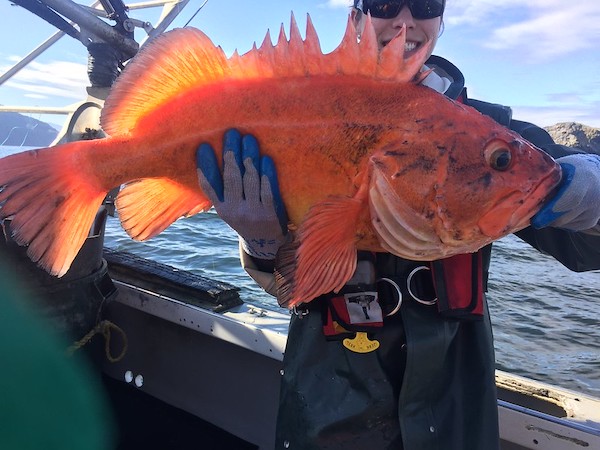
It’s World Ocean Day, a time to celebrate one of the things that makes Oregon such a special place: our Pacific Ocean. Oregon's dramatic shorelines and seascapes are teeming with life and provide rich opportunities for Oregonians to visit, recreate, fish, discover, and learn. But unfortunately, one of the most successful ocean conservation programs we have in Oregon is at risk.
 An Oregon Dept. of Fish and Wildlife Marine Reserve volunteer holds a large yelloweye rockfish, as part of a catch and release study at the Redfish Rocks Marine Reserve. Yelloweye rockfish are one of the key species of recovery in Oregon
An Oregon Dept. of Fish and Wildlife Marine Reserve volunteer holds a large yelloweye rockfish, as part of a catch and release study at the Redfish Rocks Marine Reserve. Yelloweye rockfish are one of the key species of recovery in Oregon
A decade ago, Oregonians recognized the importance of our ocean and the value of protecting it with the creation of the state’s Marine Reserves Program. Today, the reserves and protected areas around Otter Rock, Redfish Rocks, Cape Falcon, Cascade Head and Cape Perpetua make up roughly 9% of the state’s waters. These special places encompass a wide array of amazing ecosystems and habitats including rugged rocky reefs, thick kelp forests and vast sandy bottoms, abundant with life. These areas are also home to amazing wildlife from marine mammals to spineless denizens of the deep such as octopus, as well as economically important species including rockfish and Dungeness crab.
The Marine Reserves Program was established to conserve marine habitats, promote biodiversity, and provide space to conduct scientific research and monitoring. Overall, it’s been a success as a result of collaborations between ocean conservation groups, fishers, scientists and coastal communities, who have been working together for ten years to fulfill the promise of the Marine Reserves Program.
Over the past decade, with funding from the Marine Reserves Program, scientists have published over 100 research papers on topics and emerging ocean issues of significant interest to Oregonians including research on low-oxygen events, ocean acidification, a deadly coastwide disease outbreak in sea stars, and presence of microplastics in fish. The Marine Reserves Program has fostered the testing of new scientific methods for monitoring and tracking the health of species and habitats in Oregon’s nearshore ocean, has hosted community events, supported community economic development projects, and engaged more than 13,000 people in community science projects.
But the work is really just beginning.
Last year, the Oregon Department of Fish & Wildlife Marine Reserves Program completed a decadal assessment evaluating the program and making administrative and legislative recommendations. The assessment and subsequent recommendations made clear that for the Marine Reserves Program to continue succeeding, live up to its full potential and adapt to a changing climate and ocean, it needs further investment. These recommendations were subsequently endorsed by the Governor’s Oregon Ocean Policy Advisory Council and proposed in legislation (HB 2903) by the Oregon Coastal Caucus, a bipartisan, bicameral group of coastal legislators.
Puzzlingly, this legislative session, both the governor's office and legislative leadership have proposed cuts to the Marine Reserves Program in the next biennium.
Cutting funding from the marine reserves program wouldn't just threaten the designated sites themselves, but would threaten the good will of ocean communities and stakeholders. It would also undermine the research and management of critical climate change issues such as hypoxia, ocean acidification and ocean warming -- research that allows fishers and our resource-dependent coastal communities to adapt and be more resilient to these ocean changes.
This World Ocean Day, a bipartisan coalition of Oregonians and elected leaders are urging Gov. Tina Kotek and legislative leadership to turn the tide and fully fund Oregon’s marine reserves and protected areas. Oregon’s sensational coastline and the marine life under the ocean surface are well worth the investment.
Co-authored by:
Charlie Plybon, Oregon Policy Manager, Surfrider Foundation
Celeste Meiffren-Swango, State Director, Environment Oregon
Joe Liebezeit, Interim Statewide Conservation Director, Portland Audubon & Statewide Conservation Rep. on the Ocean Policy Advisory Council

